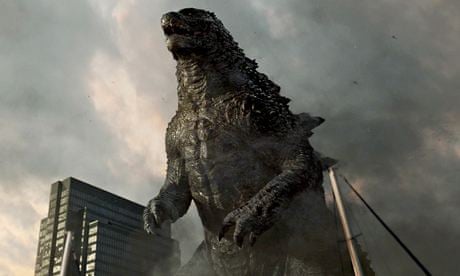Godzilla is back, for the first time in English since Roland Emmerich's blockbuster in 1998. The terrifying gigantic lizard has re-emerged from the oceans to menace the Pacific Rim in its entirety, sending everything flying in a shower of pixels. British director Gareth Edwards supervises some colossal creature-feature effects, but the human beings are on fantastically dull form and the storyline is a muddled and supercilious affair in which Godzilla may or not be the villain, fighting two other lesser CGI beasts.
Of course, Godzilla has form in battling other monsters, but for me, it puts the humans in danger of being mere collateral damage, looking and feeling irrelevant in this great big skyscraper-wrecking punch-up of the mega-behemoths. More exasperatingly, the anti-nuclear satire of the original Japanese movie has been insidiously softened. In this film, it's not at all clear that nuclear power is really to blame for the terrifying eruption. This Godzilla is sitting on the nuke fence.
Godzilla, like James Bond, was a 1950s fantasy phenomenon which grew out of national anxiety. The 1954 movie Gojira, about a sea monster summoned from the deep by nuclear tests to lay waste to Tokyo was a potent myth and a brilliant, Swiftian satire. The Brobdingnagian lizard allowed the Japanese to remember and reimagine the monstrous nuclear destruction of the war without the shame of military defeat, and then to confront the whole world with it: Godzilla told us that the nuclear age was not scientific or technological, but irrational and uncontrollable, a grotesque symptom of hubris, with the potential to amplify the smallest spasms of aggression to gigantic levels of annihilation.
This new Godzilla erupts from a modern catastrophe involving a Japanese nuclear power station that resembles Fukushima. Or does it? A strange narrative sleight of hand associates Godzilla with nuclear calamity but muddies the actual causal relationship. There's a new slant on that black-and-white newsreel footage of 1950s nuclear tests, which is ingenious, but weirdly comes close to making the nukes the heroes. It seems the monsters may fortuitously "feed on" nuclear energy, but the mighty blast of a good old-fashioned A-bomb might be what's needed to get rid of them. Or we could let Godzilla do the job and become bystanders.
Aaron Taylor-Johnson plays a young soldier, Ford Brody – a name Douglas Adams would have been proud to have invented. He is haunted by a personal demon, a big lizard of emotional pain lurking in the ocean of memory. Fifteen years earlier, his dad, Joe Brody (Bryan Cranston), was involved at the quasi-Fukushima disaster, where he was a top nuclear scientist, working with a single-minded intensity that threatened his marriage to Sandra (a slightly preposterous role for Juliette Binoche). Now Cranston has become a lonely conspiracy theorist, obsessed with what the authorities are covering up. This brings him and Ford into contact with the existing top nuclear scientists, Dr Serizawa, played by Ken Watanabe – inevitably wasted in this bland role – and his assistant, Vivienne, played by Sally Hawkins, who does a bit of frowning, nodding and stammering like a character in a Mike Leigh film.
So what are they up against? Well, at first, the demon from the depths is not Godzilla himself but something the army is calling a MUTO – a Massive Unidentified Terrestrial Organism. (Massive? Isn't that what Godzilla was supposed to be?) Unlike Godzilla, they don't get a name, just this acronym. The MUTO looks like a spider-pterodactyl with a face like one of the eagles atop New York's Chrysler Building, and there's more than one of them – one has what looks like a womb full of glowing eggs, or possibly a huge scrotum fill of glowing sperm. They could breed. Godzilla couldn't have turned up at a more dramatic moment. So should the US army blast all three of them to hell? Or gamble on Godzilla's potential for decency and let him deal with the MUTOs – which would be the ecologically correct, giant-lizard-hugging thing to do?
It all gets very tiresome, with dispiriting hints of Pacific Rim and the lumbering Transformers movies. Aaron Taylor-Johnson, so likable in the Kick-Ass films, is here dull and slow-moving beefcake. There's an awful moment when he hears the MUTO roar from afar and does an am-dram face and slooow turn, as if to say: "Oh my God, that's not a towering lizard behind me is it?" His demure wife, Elle (Elizabeth Olsen), is a hospital doctor, which means she doesn't get to do anything more than look fetching in green scrubs and watch the monster on wall-mounted TVs while the casualties pour in. The sleep of reason brings forth monsters, they say. Sadly these monsters may bring forth sleep themselves.

Comments (…)
Sign in or create your Guardian account to join the discussion